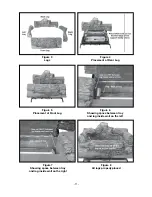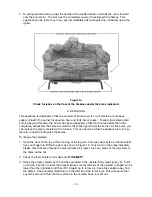
-6-
• If your home meets all three of the above criteria, you must provide additional fresh air. See
Ventilation Air from Outdoors, below. If your home does not meet all three of the above criteria,
you must next determine whether or not you are installing the appliance in a confined space.
• The National Fuel Gas Code, ANS Z223.1 defines a confined space as a space with a volume of
less than 50 cubic feet per 1,000 Btu per hour (4.8 m
3
per kw) of the aggregate input rating of all
appliances installed in that space. Rooms communicating directly with the space in which the
appliance is installed are considered a part of the space. (“Communicating directly” is defined
as having doorless passageways or ventilation grills between the two rooms.)
Use the following worksheet to determine if you have a confined or unconfined space. Remember,
space is defined as the room in which you will install the appliance plus any adjoining rooms with
doorless passageways or ventilation grills between the rooms.
Step 1: Determine the total Btu/hr of all fuel-burning appliances in the space. Include 12,000 Btu/
hr for this appliance, and add any other gas or alcohol burning appliances (such as gas
water heaters, gas furnaces, gas stoves, etc.) that are installed within the same space. Do
not include any direct-vent gas appliances, however, as these draw combustion air from
the outdoors and vent to the outdoors.
Step 2: Divide the number obtained in Step 1 by 1000.
Step 3: Determine the volume of the space (length x width x height). Add the volume for any other
rooms in the space, as defined above.
Step 4: Divide the number obtained in Step 3 by 50.
Step 5: Compare the number obtained in Step 4 with the number obtained in Step 2. If the
number from Step 4 is smaller, the space is confined, and you must provide additional
air for combustion and ventilation. If the number from Step 2 is smaller, the space is
unconfined, and you may install the appliance.
Example 1: The appliance is to be installed in a room that is 15 ft x 20 ft with 8 ft ceilings. There
are no doorless passageways or vents between rooms, and there is a 40,000 Btu/hr gas wall
heater in the room.
Step 1: Total Btu/hr = 12,000 (this duraflame
®
illuma
™
appliance) + 40,000 (gas wall heater) =
52,000 Btu/hr
Step 2: Divide by 1000: 52,000 / 1000 = 52.
Step 3: Volume of space = 15 x 20 x 8 = 2400.
Step 4: Divide by 50: 2400 / 50 = 48.
Step 5: Compare the numbers: 48 (Step 4) is smaller than 52 (Step 2), so the space is confined.
You must provide additional ventilation.
Example 2: Now let’s assume the 15 ft x 20 ft x 8 ft room with the 40,000 Btu/hr gas stove has a
doorless passageway communicating with a room that is 15 ft x 15 ft with 8 ft ceilings.
Step 1: Total Btu/hr = 12,000 (this duraflame
®
illuma
™
appliance) + 40,000 (gas wall heater) =
52,000 Btu/hr
Step 2: Divide by 1000: 52,000 / 1000 = 52.
Step 3: Volume of space = (15 x 20 x 8) + (15 x 15 x 8) = 2400 + 1800 = 4200.
Step 4: Divide by 50: 4200 / 50 = 84.


































